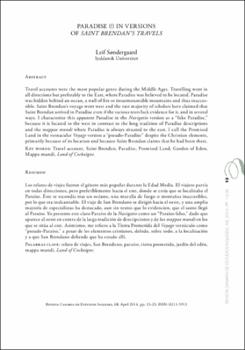Paradise (?) in Versions of Saint Brendan's Travels
Author
Sondergaard, LeifDate
2014Abstract
Los relatos de viajes fueron el género más popular durante la Edad Media. El viajero partía
en todas direcciones, pero preferiblemente hacia el este, donde se creía que se localizaba el
Paraíso. Éste se escondía tras un océano, una muralla de fuego o montañas inaccesibles,
por lo que era inalcanzable. El viaje de San Brendano se dirigió hacia el oeste, y una amplia
mayoría de especialistas ha destacado, aun sin textos que lo evidencien, que el santo llegó
al Paraíso. Yo presento este claro Paraíso de la Navigatio como un “Paraíso falso”, dado que
aparece al oeste en contra de la larga tradición de descripciones y de los mappae mundi en los
que se sitúa al este. Asimismo, me refiero a la Tierra Prometida del Voyage vernáculo como
“pseudo-Paraíso”, a pesar de los elementos cristianos, debido, sobre todo, a la localización
y a que San Brendano defiende que ha estado allí. Travel accounts were the most popular genre during the Middle Ages. Travelling went in all directions but preferably to the East, where Paradise was believed to be located. Paradise was hidden behind an ocean, a wall of fire or insurmountable mountains and thus inaccessible.
Saint Brendan's voyage went west and the vast majority of scholars have claimed that Saint Brendan arrived in Paradise even if the various texts lack evidence for it, and in several ways. I characterize this apparent Paradise in the Navigatio version as a "fake Paradise", because it is located to the west in contrast to the long tradition of Paradise descriptions and the mappae mundi where Paradise is always situated to the east. I call the Promised Land in the vernacular Voyage version a "pseudo-Paradise" despite the Christian elements, primarily because of its location and because Saint Brendan claims that he had been there.





